Ancient Metal Plates
by Daniel Johnson, 2011
“...wherefore I did make plates of ore that I might engraven upon them the record of my people.” (1 Nephi 19:1)
In March of 2011, some intriguing artifacts were popping up in online news sites, blogs, and mailing lists. Ancient codices, purporting to be books made of leaves of lead and dating to the first century ad were creating excitement and controversy around the world. They were described as being about the size as a credit card, engraved with Jewish or Christian symbols and Paleo-Hebrew writing. They were bound with metal rings; some were even sealed with rings on all sides of the plates. After that, however, their story got a bit murky. Some reports described as many as 70 codices, others as few as 20. As more pictures hit the Internet, a great variety of sizes and styles became evident. They were supposedly found in a cave in Jordan a few years ago, although they are now in Israel. The Jordanian government proclaimed that they had been illegally taken out of the country and was attempting to get them repatriated. But the current owner, an Israeli named Hassan Saeda, countered that the plates had been handed down inhis family for over a century. Unnamed ‘experts’ announced that the corrosion on the plates proved an ancient provenance,1 but mainstream scholars were skeptical from the outset.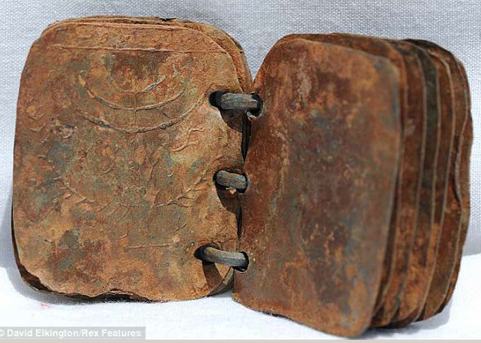 Perhaps the most damaging evidence against the plates’ authenticity lies with their most vocal advocate, British scholar and author David Elkington. He has other such finds in his possession, including what purportto be ancient bronze plates from the same region. However, because of typos in the ancient Greek text they contain, they have been unequivocally denounced as fake by experts. Even worse, one of these bronze plates contains a palm tree image that very closely matches up with a palm tree motif on one of the lead plates, leading to the almost inescapable conclusion that they were cast from the same mold. If this one lead plate is a modern creation, are all the rest fakes as well? Not necessarily, but this is a strong mark against them. More seasoned and experienced experts are now taking sides against the plates. The general scholarly consensus now is that they are forgeries. Peter Thonemann, a university lecturer in ancient history, first discovered and announced the strong evidence against them.2 LDS scholars are taking a similar position. Jeff Chadwick, a practicing field archaeologist at BYU’s Jerusalem center, agrees with that assessment.3 John Sorenson has also come to the conclusion that they are probably fakes.4
Perhaps the most damaging evidence against the plates’ authenticity lies with their most vocal advocate, British scholar and author David Elkington. He has other such finds in his possession, including what purportto be ancient bronze plates from the same region. However, because of typos in the ancient Greek text they contain, they have been unequivocally denounced as fake by experts. Even worse, one of these bronze plates contains a palm tree image that very closely matches up with a palm tree motif on one of the lead plates, leading to the almost inescapable conclusion that they were cast from the same mold. If this one lead plate is a modern creation, are all the rest fakes as well? Not necessarily, but this is a strong mark against them. More seasoned and experienced experts are now taking sides against the plates. The general scholarly consensus now is that they are forgeries. Peter Thonemann, a university lecturer in ancient history, first discovered and announced the strong evidence against them.2 LDS scholars are taking a similar position. Jeff Chadwick, a practicing field archaeologist at BYU’s Jerusalem center, agrees with that assessment.3 John Sorenson has also come to the conclusion that they are probably fakes.4
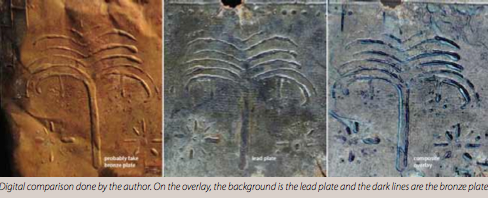
Extreme caution is warranted, and only time will tell what the truth is behind these enigmatic artifacts. The Dead Sea Scrolls’ authenticity was doubted at first, and we could be looking at a similar situation with the lead codices. They have now fallen out of the limelight just as quickly as they were thrust into it. But it is very likely that they are another in a continuing line of modern forgeries. That would be disappointing, but we are in no worse position for recognizing and accepting the truth. The validation of the lead codices as genuine artifacts would have been encouraging for Book of Mormon supporters. However, if they are faked, what were those responsible trying to copy? Forgeries are usually copies of known types of items to avoid controversy. A fake of something no one has ever seen before is inherently suspect. Why choose books made of lead plates? The fact that hoaxers unconcerned with LDS issues might be creating these kinds of relics demonstrates greater acknowledgement and acceptance of ancient metal plates. If these codices do turn out to be fakes, it should not be too discouraging. We should just accept the truth and move on. Besides, there are numerous non-controversial and widely-accepted examples of ancientwriting on metal plates, some well known and others not as much.
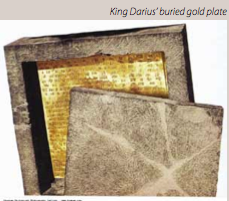
Every LDS Church member should be aware of the plates of the Persian king Darius the Great. He had the details and history of his empire written on gold and silver plates, which were then buried in stone boxes in the foundations of his palace in Persepolis.5 The plates contain his name, record the extent of his empire, and thank his god for bestowing all of it upon him. They are dated to 522 bc. These plates, unknown when the Book of Mormon was published since they were discovered n 1933, have long been held as proof of the plausibility of ancient records engraved on gold plates.
The fact that they were buried in stone boxes may also be compelling and significant. But there are 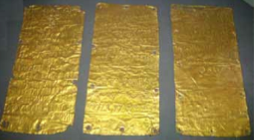 additional authentic examples of ancient writing on gold plates coming from other cultures. Some fascinating artifacts come from the Etruscans, oddly enough. In 1964, three golden plates, known today as the Pyrgi plates, were found in Santa Severa, near Rome. This was the ancient Etruscan port town of Caere. The plates date to 500 bc and record the dedication of a temple to the Phoenician goddess of fertility. Written in both Etruscan and Punic/Phoenician, they gave researchers valuable insight into this otherwise indecipherable
additional authentic examples of ancient writing on gold plates coming from other cultures. Some fascinating artifacts come from the Etruscans, oddly enough. In 1964, three golden plates, known today as the Pyrgi plates, were found in Santa Severa, near Rome. This was the ancient Etruscan port town of Caere. The plates date to 500 bc and record the dedication of a temple to the Phoenician goddess of fertility. Written in both Etruscan and Punic/Phoenician, they gave researchers valuable insight into this otherwise indecipherable 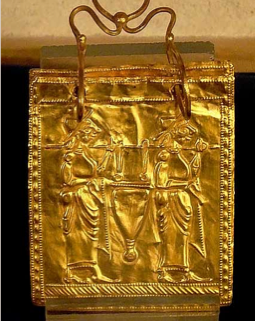 language of ancient Italy.6 They are now held at the National Etruscan Museum of Villa Giulia in Rome. The Etruscans also left what is considered today to be the oldest book bound into pages. It has six leaves made of almost 24-carat gold, engraved with images including a horseman, a mermaid,and warriors. It also has text which has not yet been deciphered.
language of ancient Italy.6 They are now held at the National Etruscan Museum of Villa Giulia in Rome. The Etruscans also left what is considered today to be the oldest book bound into pages. It has six leaves made of almost 24-carat gold, engraved with images including a horseman, a mermaid,and warriors. It also has text which has not yet been deciphered.
The book was discovered around 1943 in a tomb in the valley of the Struma River in Bulgaria. Considered the oldest book in the history of mankind, it dates to 500 bc and perhaps even earlier.7 It is displayed in Bulgaria’s National History Museum in Sofia. Other metals were used to make tablets, plates, and scrolls for recording special histories or ceremonial events. The copper scroll (known officially as 3Q15) of the Dead Sea Scrolls is but one example. Unlike the other scrolls, it is made of copper with about 1% tin and was found by an archaeologist at the back of Cave 3 in Qumran in 1952. It dates from ad 50-100 and gives an account of a vast amount of what is believed to be temple treasure.8 Because of this, it is sometimes referred to as the Treasure Scroll. This treasure, which reportedly consists of tons of gold and silver, tithing vessels, priestly vestments, and other documents, has never been found.
 This Middle Eastern artifact is well known today, but other significant finds may not be. In 1979, two small scrolls of silver were found in a burial chamberat Ketef Hinnom, an archaeological site near Jerusalem. When finally unrolled and cleaned, they were found to contain a well-known priestly blessing from Numbers 6:24-26. The scrolls were dated to the early sixth century bc and are the oldest surviving examples of Biblical text,9 predating the Dead Sea Scrolls by 400 years.
This Middle Eastern artifact is well known today, but other significant finds may not be. In 1979, two small scrolls of silver were found in a burial chamberat Ketef Hinnom, an archaeological site near Jerusalem. When finally unrolled and cleaned, they were found to contain a well-known priestly blessing from Numbers 6:24-26. The scrolls were dated to the early sixth century bc and are the oldest surviving examples of Biblical text,9 predating the Dead Sea Scrolls by 400 years.
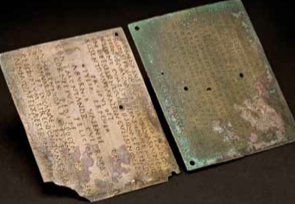
.png)
The plate is housed in the British Museum. BYU’s Harold B. Lee Library is home to an exhibit containing Roman bronze plates. Known as the Marcus Herrenius Military Diploma, these plates were made from an alloy of copper and tin during the reign of the emperor Trajan in ad 109. Far from being a unique item, these plates were bound together to form an official decree, granting honors and citizenship to a soldier named Marcus Herrenius Polymita and his family. Every successfully retiring soldier was given his own set of similar plates.11 A recent discovery confirming the earliest 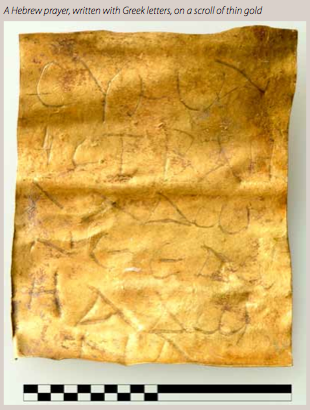 evidence of Jews living in Austria is also worth mentioning. In 2006, archaeologists from the Institute of Prehistory and Early History of the University of Vienna found what they describe as an amulet in a child’s burial from the third century ad. The gravesite in the Austrian town of Halbturn was unearthed in 1986 and excavations began in 1988, but the amulet was not noticed until later. Inside a silver capsule worn around the child’s neck was a small metal scroll. Engraved on this gold-plated artifact are the Greek letters “ΣΥΜΑ ΙΣΤΡΑΗΛ ΑΔΩNΕ ΕΛΩΗ ΑΔΩN Α.”12 However, this is not Greek. When read aloud, it transliterates roughly as, “Suma Istrahel Adone Elon Adon a.” This is Hebrew, written in the Greek alphabet, recording a prayer from Duteronomy 6:4. This is an astounding discovery because it proves that Greek speaking Jews who could not read Hebrew wanted to be able to recite a passage from the Old Testament in its original language. In order to do this, the Hebrew phrase had to be written in a language they could read. This appears to be a rare occurrence, but it may give new insight into Nephi’s description of making his record in the language of his father, which consisted of “the learning of the Jews and the language of the Egyptians” (1 Nephi 1:2). Instead of writing his record in Hebrew, which should have been the preferred language, Egyptian was chosen for some unspecified reason. Much later in Nephite history, Moroni explains that he and other Nephite scribes used what they called reformed Egyptian. Hebrew would have been preferable, although the Nephites had altered both Hebrew and Egyptian by this time, but Egyptian was chosen because apparently more information could be rendered with fewer characters (Mormon 9:32-33). Space on or the number of plates must have been at a premium. Based on Nephi’s explanation, most LDS scholars have concluded that the Book of Mormon was originally written in Hebrew, but with Egyptian rather than Hebrew characters.13 In Joseph Smith’s day, such an assertion would have been unthinkable. It is still scoffed at today, but this tiny gold scroll from Austria proves that such things did indeed happen.
evidence of Jews living in Austria is also worth mentioning. In 2006, archaeologists from the Institute of Prehistory and Early History of the University of Vienna found what they describe as an amulet in a child’s burial from the third century ad. The gravesite in the Austrian town of Halbturn was unearthed in 1986 and excavations began in 1988, but the amulet was not noticed until later. Inside a silver capsule worn around the child’s neck was a small metal scroll. Engraved on this gold-plated artifact are the Greek letters “ΣΥΜΑ ΙΣΤΡΑΗΛ ΑΔΩNΕ ΕΛΩΗ ΑΔΩN Α.”12 However, this is not Greek. When read aloud, it transliterates roughly as, “Suma Istrahel Adone Elon Adon a.” This is Hebrew, written in the Greek alphabet, recording a prayer from Duteronomy 6:4. This is an astounding discovery because it proves that Greek speaking Jews who could not read Hebrew wanted to be able to recite a passage from the Old Testament in its original language. In order to do this, the Hebrew phrase had to be written in a language they could read. This appears to be a rare occurrence, but it may give new insight into Nephi’s description of making his record in the language of his father, which consisted of “the learning of the Jews and the language of the Egyptians” (1 Nephi 1:2). Instead of writing his record in Hebrew, which should have been the preferred language, Egyptian was chosen for some unspecified reason. Much later in Nephite history, Moroni explains that he and other Nephite scribes used what they called reformed Egyptian. Hebrew would have been preferable, although the Nephites had altered both Hebrew and Egyptian by this time, but Egyptian was chosen because apparently more information could be rendered with fewer characters (Mormon 9:32-33). Space on or the number of plates must have been at a premium. Based on Nephi’s explanation, most LDS scholars have concluded that the Book of Mormon was originally written in Hebrew, but with Egyptian rather than Hebrew characters.13 In Joseph Smith’s day, such an assertion would have been unthinkable. It is still scoffed at today, but this tiny gold scroll from Austria proves that such things did indeed happen.
The preceding examples of writing on ancient metal plates or scrolls share some interesting characteristics. With the exception of the Roman plates which were meant to be used as public documents, they mostly contained scriptural, historical, or ceremonial writing; they were buried or hidden; and they were extremely significant to those who wrote or possessed them. In addition, they all come from cultures that originated in the ancient Middle East or Mediterranean and none of them were known when the Book of Mormon was published or at any time during Joseph Smith’s life.life. The importance of these latter shared commonalities cannot be overstated. If Joseph was making up his story of an ancient record on golden plates, he had no historical precedent upon which to draw; it sounded like no more than a tall tale. Those who do not believe the Book of Mormon casually disregard his assertions, but would do well to remember that in his early days, when he actually claimed to have the plates in his possession, friends, associates, and enemies alike firmly believed he had something of great value, as evidenced by repeated attempts to find or steal them.
The preceding examples of metal plates from all throughout the Mediterranean area show that Joseph was really ahead of his time when he made his claim. If the golden plates were merely a fraudulent invention, he made a pretty good guess. Time has given his story more plausibility. It should be noticed that all of these examples which are universally considered legitimate and authentic originate in the Old World. Since the Book of Mormon was a record written and hidden up in the Americas, should there not also be similar artifacts from the New World? That might be hoped, but as of yet no universally-accepted examples of extensive writing on Ancient American metal plates are known. Among the LDS community, faith-promoting stories of secret records on gold or metal plates are occasionally circulated, but the best that can be said about any of these reputed artifacts is that they are extremely controversial, of uncertain provenance, or completely unknown to the scholarly community. In many cases, they are merely stories with no artifacts available for study. Of course, this does not mean that there is no truth to these tales. It is possible that some native peoples kept sacred records in this way and have not shared that knowledge with outsiders. Aside from the Kinderhook Plates, which were purportedly fabricated for the sole purpose of discrediting Joseph Smith, a few still have uncertain authenticity, like the Sopher Tablets and various metal plates supposedly found buried near Manti, Utah.14 Such items have not been included in this paper because of all the controversies surrounding them. Many are likely hoaxes, and even if they are not, there is no scholarly literature that deals with them. Of course, artifacts of thin gold plates from Mesoamerica do exist. Gold plates and other items found in a tomb at Monte Albán are currently housed in a museum in Oaxaca, Mexico. The author has examined and written about late Classic Maya gold plates and disks found in the Sacred Cenote at Chichén Itzá. Some of them have Mayan hieroglyphics carved or embossed into them. Such items probably have no direct connection to the Book of Mormon, but they are still noteworthy in that they were unknown during Joseph Smith’s time and they do provide some support for gold plates from ancient America. However, plates mentioned in the Book of Mormon, such as Laban’s plates of brass, Ether’s 24 gold plates, and the record that Moroni eventually buried were all made by cultures that lived in or originally came from the Middle East. Modern archaeological discoveries actually support this aspect of the Book of Mormon and this is certainly an encouraging point amid the challenges that are continually flung our way..
Notes
1 22-04-2011. <12-22-2009. <http://www.bbc.co.uk/news/world-middle-east-12888421>.
2 22-04-2011. < http://danielomcclellan.wordpress.com/2011/03/31/peter-thonemann-on-the-....
3 22-04-2011. < http://www.deseretnews.com/article/700123230/Ancient-metal-plates-found-...html?pg=1>.
4 Personal communication by e-mail, 7 April 2011.
5 22-04-2011. < http://en.wikipedia.org/wiki/Persepolis>.
6 23-04-2011. < http://www.marcellenassif.com/2008/04/pyrgi-tablets-ancient-tangible-pro....
7 23-04-2011. < http://english.pravda.ru/society/showbiz/28-05-2003/2940-etruscan-0/>.
8 23-03-2011. < http://en.wikipedia.org/wiki/Copper_Scroll>.
9 23-04-2011. < http://www.historyofinformation.com/index.php?category=Religious+Texts+%....
10 24-04-2011. < http://en.wikipedia.org/wiki/Taxila_copper_plate>.
11 24-04-2011. < http://romanplates.byu.edu/Roman_Gallery_Guide.pdf>.
12 24-04-2011<http://public.univie.ac.at/index.phpid=6766&no_cache=1&tx_ttnews[tt_news...ackPid]=6093&cHash>.
13 24-04-2011. < http://maxwellinstitute.byu.edu/publications/books/?bookid=98&chapid=1086>.
14 See Jerry L. Ainsworth, The Lives and Travels of Mormon and Moroni (PeaceMakers Publishing, 2000), pp. 210-212.


